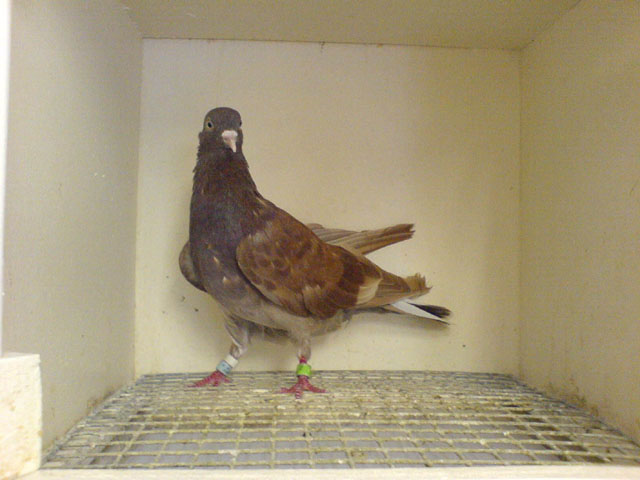Domestic Pigeon (Columba livia domestica) - Wiki Domestic Pigeon
From Wikipedia, the free encyclopedia
[Photo] Red Sheffield domestic homing pigeon; A.S. Knobbout, Red Sheffield Cock, flew 20.58 Long-day 2005. Date 28 August 2005. Photo by http://en.wikipedia.org/wiki/User:Tippler License: public domain.
The domestic pigeon (Columba livia domestica) was derived from the Rock Pigeon. Rock Pigeons have been domesticated for several thousand years.
Pigeons have made contributions of considerable importance to humanity, especially in times of war. In war the homing ability of pigeons has been put to use by making them messengers. So-called war pigeons have carried many vital messages and some have been decorated for their service. Medals such as the Croix de guerre, awarded to Cher Ami, and the Dickin Medal awarded to G.I. Joe have been given to pigeons for their service. Despite the above many people consider pigeons to be pests.
Reproduction
Domestic pigeons reproduce in a similar way to the wild Rock Pigeon. Generally humans will select breeding partners. Crop milk produced by parent birds may occasionally be replaced with artificial substitutes. See Also:-Gallery
Homing pigeons
Trained domestic pigeons are able to return to the home loft if released at a location that they have never visited before and that may be up to 1000 km away. A special breed, called homing pigeons has been developed through selective breeding to carry messages and members of this variety of pigeon are still being used in pigeon racing.
Pigeons' extraordinary navigation abilities have been attributed to the theory that they are able to sense the Earth's magnetic field with tiny magnetic tissues in their head (magnetoception). This is all the more surprising as they are not a migratory species, which is a fact used by some ornithologists to dispute the "compass pigeon" theory.
Other purposes of pigeon breeding
Squab production
Pigeons are also bred for meat. Pigeons grow to a very large size in the nest before they are fledged and able to fly, and in this stage of their development (when they are called squabs) they are prized as food. Young pigeon meat is often sold under the name squab. For commercial meat production a breed of large white pigeon, named "King pigeons," has been developed by selective breeding. Breeds of Pigeons developed for their meat are collectively known as "Utility Pigeons".
Exhibition breeds
Fanciers developed many exotic forms of pigeon. These are generally classed as Fancy pigeons. Among those forms are the carrier pigeons, a variety of pigeon with wattles and a unique, almost vertical, stance (pictures). There are many ornamental breeds of pigeons, including the "Duchess" breed, which has as a prominent characteristic feet that are completely covered by a sort of fan of feathers. The Fantails are also very ornamental with their fan-shaped tail feathers.
Experimentation
Domestic pigeons are also commonly used in laboratory experiments in biology, medicine and cognitive science.
Cognitive science
They have been trained to distinguish between cubist and impressionist paintings, for instance. In another project, pigeons were shown to be more effective than humans in spotting shipwreck victims at sea. Research in pigeons is widespread, encompassing shape and texture perception, exemplar and prototype memory, category-based and associative concepts, and many more unlisted here (see Pigeon intelligence and discrimination abilities of pigeons).
Illegally killing predators
In the US, some pigeon keepers illegally trap and kill hawks and falcons to protect their pets, as they can pose a threat to their pigeons. In American pigeon-related organizations, enthusiasts often openly share their experiences of killing hawks and falcons. It is estimated that almost 1000 birds of prey have been killed in Oregon and Washington, and that 1 to 2 thousand are killed in southern California annually. In June 2007, three Oregon men were indicted with misdemeanour violations of the Migratory Bird Treaty Act for killing birds of prey. Seven Californians and a Texan have also been charged in the case.
Pigeon Lung
Pigeon breeders sometimes suffer from an ailment known as Pigeon Lung. A form of hypersensitivity pneumonitis, Pigeon Lung is caused by the inhalation of the avian proteins found in feathers and dung. It can sometimes be combatted by wearing a filtered mask.
Feral pigeons
Many domestic birds have escaped or been released over the years, and have given rise to the feral pigeon. These show a variety of plumages, although some look very like the pure Rock Pigeons. The scarcity of the pure wild species is partly due to interbreeding with feral birds.
http://en.wikipedia.org/wiki/Domestic_Pigeon
| The text in this page is based on the copyrighted Wikipedia article shown in above URL. It is used under the GNU Free Documentation License. You may redistribute it, verbatim or modified, providing that you comply with the terms of the GFDL. |
